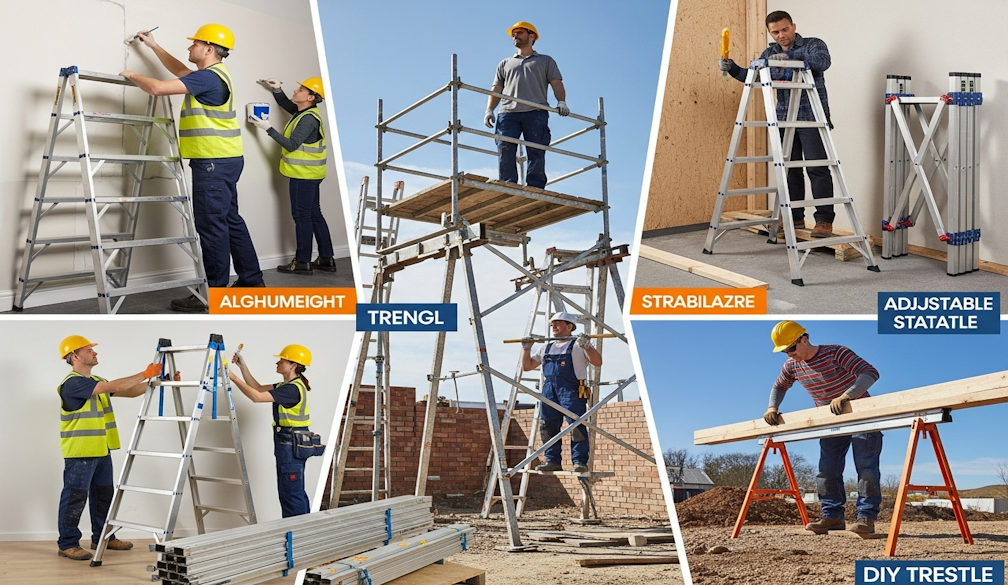Choosing the Right Scaffold Trestles for Different Projects

Whether you’re a professional tradesperson or a DIY enthusiast, working at height demands reliable equipment. Safety, stability, and efficiency all depend on having the right tools for the job. Among the most versatile and practical pieces of access equipment available today are scaffold trestles.
Used across construction, painting, carpentry, and maintenance projects, scaffold trestles provide a sturdy platform that allows workers to perform tasks securely and with confidence. However, not all trestles are the same choosing the right type for your project is key to ensuring safety and productivity.
Understanding Scaffold Trestles
Scaffold trestles are adjustable supports that hold planks or platforms, creating a stable working surface at varying heights. They are often used as an alternative to full scaffolding systems, especially for smaller-scale or short-term projects.
Available in different materials and designs, trestles can be adjusted to suit a wide range of applications from indoor finishing work to large-scale outdoor construction. The key to selecting the right type lies in understanding your project’s scope, environment, and safety requirements.
Types of Scaffold Trestles
- Aluminium Trestles
Aluminium trestles are lightweight yet durable, making them easy to transport and set up. They are resistant to rust and corrosion, which makes them ideal for both indoor and outdoor use. Their portability is particularly valuable for painters, electricians, and maintenance workers who need to move equipment frequently between sites. - Steel Trestles
Known for their superior strength and load-bearing capacity, steel trestles are better suited for heavy-duty applications such as construction, bricklaying, or industrial maintenance. They provide a high level of stability on uneven or demanding surfaces, though they are heavier and require more effort to move compared to aluminium options. - Adjustable Trestles
Adjustable trestles allow users to modify the working height to suit different tasks. They are particularly useful when working on multi-level projects or uneven ground. The adjustable legs provide flexibility and help maintain balance, ensuring a safe and level working platform. - Folding Trestles
Folding trestles are designed for convenience and space-saving. They can be quickly assembled and disassembled, making them ideal for tradespeople who work across multiple locations. While typically lighter and more compact, they may not offer the same load capacity as fixed or heavy-duty models.
Factors to Consider When Choosing Scaffold Trestles
- Project Type and Duration
Consider the nature of your project. For long-term, heavy-duty construction, steel trestles offer the durability and strength needed to support larger weights and withstand daily use. For lighter, short-term projects like painting or plastering, aluminium trestles may be more suitable due to their ease of handling and quick setup. - Height Requirements
Determine the height at which you’ll be working. Adjustable trestles are ideal when flexibility is needed, while fixed-height trestles can be more stable for repetitive, same-level tasks. Always ensure the chosen trestle allows you to work comfortably without overreaching or compromising balance. - Load Capacity
Each trestle has a maximum weight limit, including the combined weight of the worker, tools, and materials. Always check the manufacturer’s specifications and avoid exceeding these limits. Overloading can weaken the structure and increase the risk of accidents. - Safety Standards
When selecting trestles, ensure they comply with Australian safety standards and regulations. Look for features like anti-slip surfaces, secure locking mechanisms, and stable footing. Using certified equipment reduces risk and ensures a safer work environment. - Work Environment
The setting of your project also influences the type of trestle required. For outdoor projects, corrosion-resistant materials such as aluminium are best. For rough or uneven surfaces, trestles with adjustable legs and wide bases provide greater stability.
The Role of Planks and Accessories
Trestles are typically used in combination with scaffold planks to create a working platform. Using the right planks is just as important as choosing the trestle itself. Ensure that planks are strong, well-maintained, and properly secured to avoid movement or slippage during use.
Accessories such as guardrails, braces, or stabilisers can further enhance safety, especially for projects at greater heights.
Safety First
Regardless of the type of trestle you choose, following proper safety practices is essential. Always inspect equipment before use, ensure it is placed on a stable surface, and avoid overreaching. Regular maintenance and safe storage will extend the life of your trestles and reduce the risk of accidents.
Final Thoughts
Choosing the right scaffold trestles can make a significant difference in the safety, efficiency, and quality of your work. From lightweight aluminium models to heavy-duty steel options, there’s a solution for every project.
By considering factors like height, load capacity, and environment, you can select the best trestle setup to meet your needs ensuring every job is done safely, efficiently, and to the highest standard.
For reliable, durable, and versatile scaffold trestles, investing in quality equipment from a trusted supplier is a smart move that pays off on every project.









